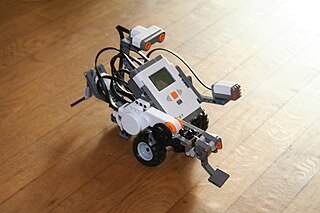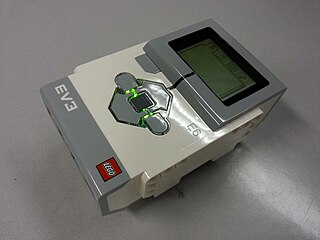Related Research Articles

An embedded system is a computer system—a combination of a computer processor, computer memory, and input/output peripheral devices—that has a dedicated function within a larger mechanical or electronic system. It is embedded as part of a complete device often including electrical or electronic hardware and mechanical parts. Because an embedded system typically controls physical operations of the machine that it is embedded within, it often has real-time computing constraints. Embedded systems control many devices in common use today. In 2009, it was estimated that ninety-eight percent of all microprocessors manufactured were used in embedded systems.

An industrial robot is a robot system used for manufacturing. Industrial robots are automated, programmable and capable of movement on three or more axes.

Lego Mindstorms was a hardware and software structure which develops programmable robots based on Lego building blocks. Each version includes computer Lego bricks, a set of modular sensors and motors, and parts from the Lego Technic line to create the mechanical systems. The system is controlled by the Lego bricks.
BCC may refer to:
leJOS is a firmware replacement for Lego Mindstorms programmable bricks. Different variants of the software support the original Robotics Invention System, the NXT, and the EV3. It includes a Java virtual machine, which allows Lego Mindstorms robots to be programmed in the Java programming language. It also includes 'iCommand.jar' which allows you to communicate via bluetooth with the original firmware of the Mindstorm. It is often used for teaching Java to first-year computer science students. The leJOS-based robot Jitter flew around on the International Space Station in December 2001.
The MCP is the operating system of the Burroughs B5000/B5500/B5700 and the B6500 and successors, including the Unisys Clearpath/MCP systems.
Not Quite C (NQC) is a programming language, application programming interface (API), and native bytecode compiler toolkit for the Lego Mindstorms, Cybermaster and LEGO Spybotics systems. It is based primarily on the C language but has specific limitations, such as the maximum number of subroutines and variables allowed, which differ depending on the version of firmware the RCX has. The language was invented by David Baum. He has released two books on the subject.

BIG TRAK / bigtrak is a programmable toy electric vehicle created by Milton Bradley in 1979, resembling a futuristic Sci-Fi tank / utility vehicle, possibly for use on the Moon or a Planetoid style environment. The original Big Trak was a six-wheeled tank with a front-mounted blue "photon beam" headlamp, and a keypad on top. The toy could remember up to 16 commands, which it then executed in sequence. There also was an optional cargo trailer accessory, with the UK version being white to match its colour scheme; once hooked to the Bigtrak, this trailer could be programmed to dump its payload.
Robot software is the set of coded commands or instructions that tell a mechanical device and electronic system, known together as a robot, what tasks to perform. Robot software is used to perform autonomous tasks. Many software systems and frameworks have been proposed to make programming robots easier.
Interactive C is a program which uses a modified version of ANSI C with several libraries and features that allow hobbyists to program small robotics platforms.

Lego Mindstorms NXT is a programmable robotics kit released by Lego on August 2, 2006. It replaced the first-generation Lego Mindstorms kit, which was called the Robotics Invention System. The base kit ships in two versions: the Retail Version and the Education Base Set. It comes with the NXT-G programming software, or optionally LabVIEW for Lego Mindstorms. A variety of unofficial languages exist, such as NXC, NBC, leJOS NXJ, and RobotC. The second generation of the set, the Lego Mindstorms NXT 2.0, was released on August 1, 2009, featuring a color sensor and other upgraded capabilities. The third generation, the EV3, was released in September 2013.
Next Byte Codes (NBC) is a simple language with an assembly language syntax that can be used to program Lego Mindstorms NXT programmable bricks. The command line compiler outputs NXT compatible machine code, and is supported on Windows, Mac OS and Linux. It is maintained by John Hansen, a Mindstorms Developer Program member.
NXC may refer to:
Urbi is an open-source cross-platform software computing platform written in C++ used to develop applications for robotics and complex systems. Urbi is based on the UObject distributed C++ component architecture. It also includes the urbiscript orchestration language which is a parallel and event-driven script language. UObject components can be plugged into urbiscript and appear as native objects that can be scripted to specify their interactions and data exchanges. UObjects can be linked to the urbiscript interpreter, or executed as autonomous processes in "remote" mode.

Bricx Command Center (BricxCC) is the integrated development environment (IDE) of Next Byte Codes (NBC), Not Quite C (NQC) and Not eXactly C (NXC). These programming languages are used to program the Robots in the Lego Mindstorms series. Not Quite C and Not eXactly C have a syntax like C. Bricx Command Center is currently limited to computers running the Microsoft Windows operating system. However, a version for the Linux operating system is currently in development. It is written by John Hansen.

LEGO Mindstorms EV3 is the third generation robotics kit in LEGO's Mindstorms line. It is the successor to the second generation LEGO Mindstorms NXT kit. The "EV" designation refers to the "evolution" of the Mindstorms product line. "3" refers to the fact that it is the third generation of computer modules - first was the RCX and the second is the NXT. It was officially announced on January 4, 2013, and was released in stores on September 1, 2013. The education edition was released on August 1, 2013. There are many competitions using this set, including the FIRST LEGO League Challenge and the World Robot Olympiad, sponsored by LEGO.

Salvius is the first open source humanoid robot to be built in the United States. Introduced in 2008, Salvius, whose name is derived from the word 'salvaged', has been constructed with an emphasis on using recycled components and materials to reduce the costs of designing and construction. The robot is designed to be able to perform a wide range of tasks by having a body structure that is similar to that of a human. The primary goal for Salvius is to create a robot that can function dynamically in a domestic environment.